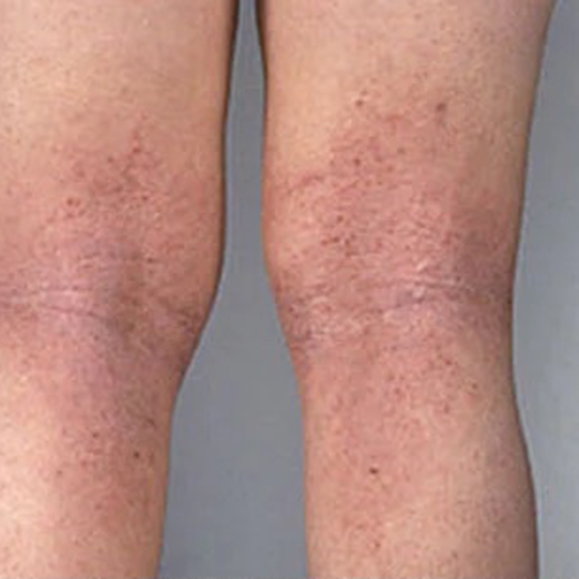Atopic dermatitis/eczema
Home • Dermatology • Common Skin Conditions • Atopic dermatitis/eczemaAbout
Atopic dermatitis, commonly referred to as eczema, is a chronic skin condition characterized by itchy and inflamed skin.
AboutSymptoms
Symptoms of atopic dermatitis can vary significantly from one individual to another but generally include:
- Itchy skin, which can be intense and often worsens at night.
- Red to brownish-gray patches, especially on the hands, feet, ankles, wrists, neck, upper chest, eyelids, inside the bend of elbows and knees, and in infants, the face and scalp.
- Small, raised bumps, which may leak fluid and crust over when scratched.
- Thickened, cracked, dry, scaly skin.
- Raw, sensitive, swollen skin from scratching.
Age-Specific Manifestations
Atopic dermatitis symptoms and affected areas can differ significantly by age:
- Infants typically experience rashes on the scalp and face, especially on the cheeks, and these rashes may bubble up and then weep fluid.
- Children from ages 2 until puberty may have rashes that appear behind the creases of elbows or knees. Other common areas include the neck, wrists, ankles, and the crease between buttock and legs.
- Adults often see rashes in the creases of their elbows or knees and on the nape of the neck, but rashes can cover much of the body and can be especially noticeable on the face and around the eyes.
Causes
Atopic dermatitis is believed to be caused by a combination of genetic, environmental, and immune system factors. The condition is commonly found in families with a history of allergies or asthma, suggesting a strong genetic link. Environmental factors like irritants in soaps, detergents, shampoos, disinfectants, or even contact with certain fabrics can trigger the disease. Additionally, food allergies may play a role in exacerbating the condition.
CausesTreatments
There is no cure for atopic dermatitis, but treatments and skin care regimens can relieve itching and prevent new outbreaks:
- Skin Care: Regular moisturizing, using ointments such as petroleum jelly, or creams that are free of alcohol, scents, dyes, and other chemicals that can irritate the skin.
- Medications: Topical corticosteroids are commonly used to reduce inflammation and itching. Other topicals that work on the immune system are also effective, and are used in places where topical steroids shouldn’t be used or in patients that need to use topicals for a long period of time. Recent advancements in the treatment of atopic dermatitis focus on targeting specific parts of the immune system that contribute to inflammation:
- Biologics: These are newer drugs that specifically target immune cells or proteins involved in the inflammatory process of atopic dermatitis. Dupixent has been FDA-approved since 2017 and has been life-changing for atopic dermatitis patients. Adbry is newer to the market and in similar in its safety and effectiveness.
- JAK inhibitors: Another class of medication that has shown promise in treating severe cases of atopic dermatitis by blocking specific pathways involved in the immune response. Rinvoq and Cibinqo are examples of these medications.
- Trigger Avoidance: Identifying and avoiding irritants that trigger flare-ups is a critical component of managing the condition.
Lifestyle Impacts
The management of atopic dermatitis can be significantly influenced by lifestyle factors:
- Diet: Some individuals may find that certain foods exacerbate their symptoms. While food allergies are also more common in people with atopic dermatitis, it’s important to consult with a healthcare provider before making dietary changes.
- Stress: Emotional stress is known to trigger or worsen symptoms, so stress management techniques such as mindfulness, yoga, or therapy can be beneficial.
- Environment: Dry air, particularly in winter, can exacerbate the dryness and itchiness. Using a humidifier and avoiding extreme temperatures can help manage symptoms.
